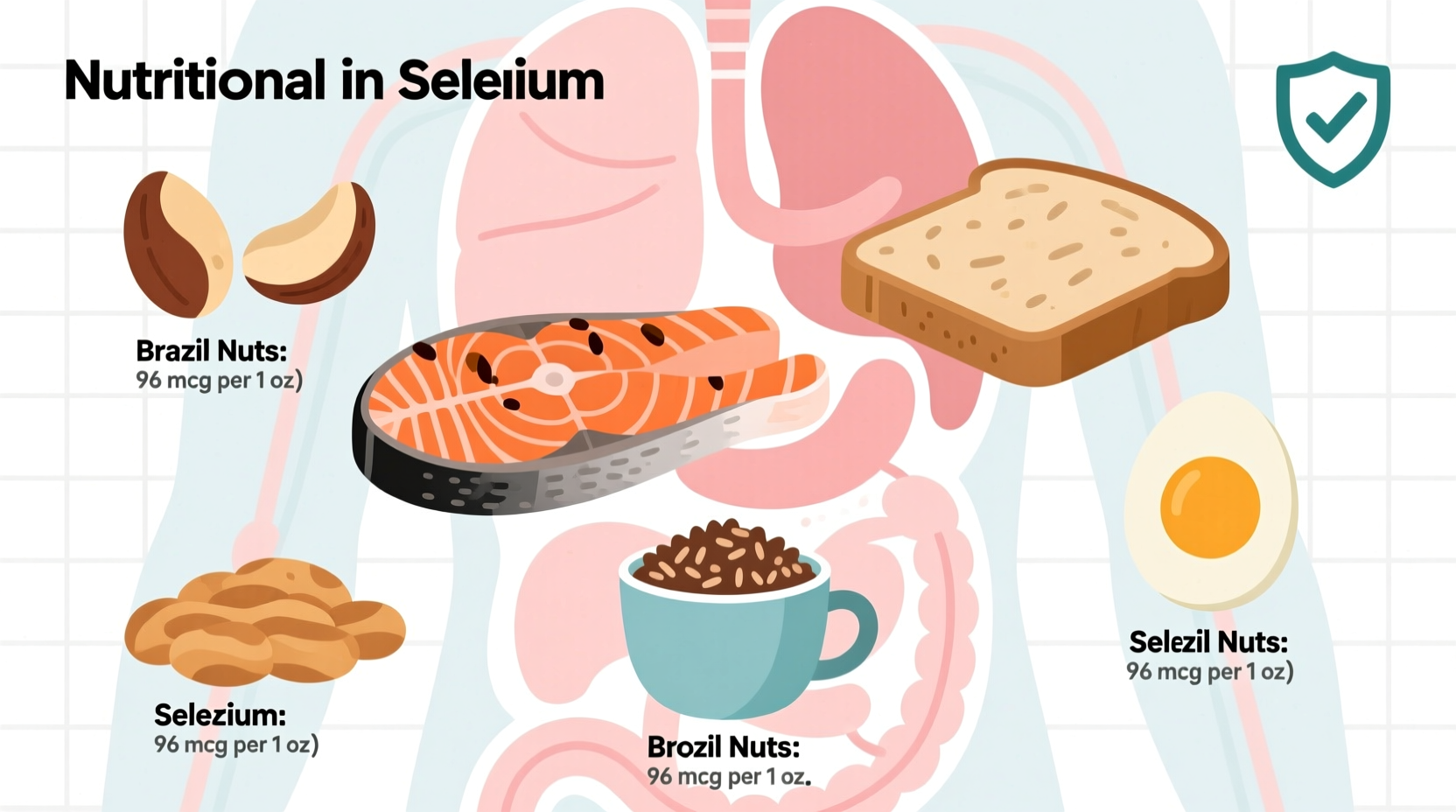Understanding which foods contain selenium is essential for maintaining optimal thyroid function, supporting your immune system, and protecting against oxidative damage. Selenium deficiency affects approximately 1 billion people worldwide according to the World Health Organization, particularly in regions with selenium-poor soils. This comprehensive guide delivers science-backed information about selenium-rich foods, their precise nutrient content, and practical ways to incorporate them into your diet—whether you follow omnivorous, vegetarian, or special dietary patterns.
Why Selenium Matters for Your Health
Selenium serves as a critical component of antioxidant enzymes that protect your cells from damage. The NIH Office of Dietary Supplements confirms that adequate selenium intake supports proper thyroid hormone metabolism, reduces inflammation, and may lower the risk of certain cancers. Adults require 55 micrograms (mcg) daily, with pregnant women needing 60 mcg and lactating women 70 mcg. Both deficiency and excess can cause health problems, making balanced intake through food sources preferable to supplementation for most people.
Your Practical Guide to Selenium-Rich Foods
When evaluating selenium sources, consider both concentration and bioavailability. Animal-based sources generally offer selenium in the highly absorbable selenomethionine form, while plant sources vary significantly based on soil conditions where they were grown. Here's how to maximize your selenium intake through everyday foods:
Top Animal-Based Selenium Sources
Seafood consistently ranks among the richest selenium sources due to marine ecosystems' selenium concentration. Organ meats also provide exceptional amounts, though they're less commonly consumed. For reliable daily intake, incorporate these options:
- Fish: Just 3 ounces of yellowfin tuna delivers 92 mcg (167% DV), while halibut provides 47 mcg (85% DV) and sardines offer 45 mcg (82% DV)
- Poultry: Turkey breast (31 mcg per 3 oz serving) and chicken (22 mcg) provide substantial amounts with versatile cooking options
- Beef: A 3-ounce serving contains 28 mcg (51% DV), with organ meats like kidney offering significantly higher concentrations
- Eggs: One large egg contains 15 mcg (27% DV), making them an accessible daily source
Plant-Based Selenium Options
For vegetarians and vegans, selenium intake requires more strategic planning due to soil-dependent variation. Brazil nuts stand out as the exception—just one nut often contains the entire daily requirement. Other reliable plant sources include:
- Brazil nuts: The undisputed champion with 544 mcg per ounce (989% DV)—consumption should be limited to 1-2 nuts daily to avoid excess
- Whole grains: Oats (13 mcg per cooked cup) and brown rice (19 mcg per cooked cup) provide moderate amounts
- Legumes: Lentils (6 mcg per cooked cup) and beans offer smaller but consistent contributions
- Seeds: Sunflower seeds (19 mcg per ounce) and chia seeds (11 mcg) add selenium plus healthy fats
| Food Source | Serving Size | Selenium (mcg) | % Daily Value | Bioavailability Notes |
|---|---|---|---|---|
| Brazil nuts | 1 ounce (6-8 nuts) | 544 | 989% | Extremely high but variable; limit to 1-2 nuts daily |
| Yellowfin tuna | 3 ounces | 92 | 167% | Highly bioavailable selenomethionine form |
| Halibut | 3 ounces | 47 | 85% | Consistent marine source |
| Turkey breast | 3 ounces | 31 | 56% | Lean protein option |
| Beef | 3 ounces | 28 | 51% | Grass-fed may contain slightly more |
| Brown rice | 1 cup cooked | 19 | 35% | Soil-dependent; US-grown typically higher |
| Eggs | 1 large | 15 | 27% | Yolk contains most selenium |

Geographic Variations in Selenium Content
Selenium concentration in plant foods varies dramatically based on soil conditions—a critical context boundary often overlooked. According to USDA soil surveys, selenium-poor regions include parts of China, Russia, New Zealand, and the northeastern United States, while selenium-rich areas include the Great Plains of the US, Canada's prairie provinces, and Venezuela. This explains why Brazilian-grown Brazil nuts contain significantly more selenium than those from Bolivia. If you live in a selenium-deficient region, prioritize animal-based sources or consider region-specific plant sources known for higher selenium content.
Smart Selenium Integration for Your Diet
Instead of focusing on individual high-selenium foods, create balanced meals that naturally incorporate multiple sources. For breakfast, try scrambled eggs with whole grain toast. At lunch, enjoy a tuna salad sandwich on whole wheat bread. For dinner, pair grilled salmon with brown rice and roasted sunflower seeds. Vegetarians can create a nutrient-dense meal with one Brazil nut, lentil soup, and whole grain bread. Remember that selenium works synergistically with other nutrients—pairing selenium-rich foods with vitamin E sources like almonds enhances antioxidant protection.
Special Considerations for Optimal Intake
Certain populations require special attention to selenium intake. People with thyroid conditions often benefit from adequate selenium, as research published in Thyroid journal shows it may reduce thyroid antibody levels. Those following plant-based diets should monitor intake carefully, as soil variations significantly impact plant selenium content. Individuals with HIV or those undergoing kidney dialysis may have increased selenium requirements. Always consult with a healthcare provider before making significant dietary changes, especially if managing health conditions.
Timeline of Selenium Understanding
Selenium's nutritional importance wasn't recognized until relatively recently. Discovered in 1817 by Jöns Jacob Berzelius, selenium was initially considered toxic. It wasn't until the 1950s that researchers connected selenium deficiency to liver disease in animals. The 1970s brought the groundbreaking discovery that selenium is part of the antioxidant enzyme glutathione peroxidase. In 1989, the link between selenium deficiency and Keshan disease (a potentially fatal heart condition) in China established selenium as essential for human health. Today, ongoing research explores selenium's role in cancer prevention and cognitive health.











 浙公网安备
33010002000092号
浙公网安备
33010002000092号 浙B2-20120091-4
浙B2-20120091-4